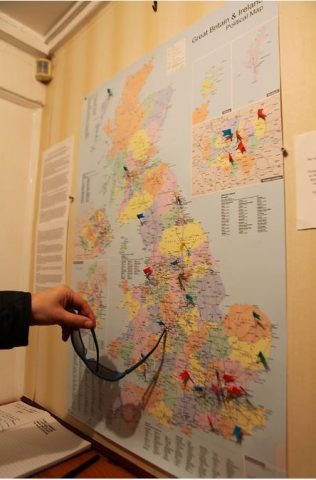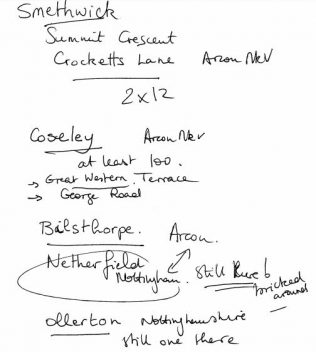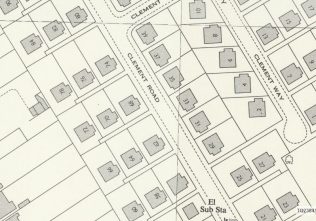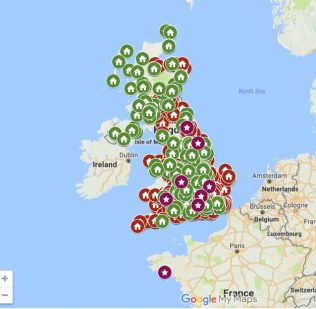Mapping Britain's post-war prefabs




I started plotting the online prefab locations map nearly eight years ago, a couple of months after we closed the Prefab Museum in Catford in November 2014.
The physical map on the wall in the hallway was smoke damaged and I had to rely on photos we had taken of it, entries in the visitors’ book, emails and Facebook posts. Some information was very specific, with street names and numbers (even descriptions of neighbours, and their pets!) others less so. After the museum closed we continued to receive locations and descriptions and it seemed appropriate to record them in one place that could be accessed by everyone with a connection to the internet.
156,623 prefabs were erected across the UK. From imported American and Swedish prefabs to the prefabs manufactured for the Temporary Housing Programme (Emergency Factory Made Homes), they turn up in the most and least likely of places. How they were distributed is easy, where they all ended up is trickier!
The Government commissioned the manufacture of, and owned, the prefabs. Local authorities applied for the number of prefabs they required, and were tasked to acquire and prepare the sites to receive them. To aid them, local authorities were given compulsory purchase powers to acquire land and empty homes. This proved difficult in some cases, and a clause was added to the Temporary Housing Programme to site prefabs on parks and open spaces for a limited length of time. Local authorities managed the allocations, collected the rents, and were paid an annual maintenance grant for 10 years after which they were given the option to purchase the prefabs.
Bombing destroyed good housing along with the bad, and some local authorities had already made plans for council housing before the Second World War intervened. Other authorities had seen their population increase by evacuees. Across the UK from the Outer Hebrides to the Isle of Wight, there was an acute shortage of homes. The result is a patchwork of distribution across the UK, from mega-prefab estates like Belle Vale in Liverpool, Shrublands in Norfolk and Harold Hill in Essex, to one or two prefabs shoe-horned on to a bomb site or empty space.
Looking at the old maps provides a window into the past of how industrialised the big cities were and how rural and undeveloped the countryside was, less than 70 years ago. They paint vivid pictures of how we lived then, our proximity to and distance from our places of work and leisure.
Sources and resources
I discovered the National Library of Scotland historic Ordnance Survey maps, particularly the London/TQ, 1:1.250/1:2500 1947-64 series which covers Greater London and parts of Kent, Essex, Surrey and Sussex. This fantastic project to overlay historic maps of the UK on a current Bing map is now being jointly developed with other map archives such as Bristol’s Know Your Place. These fine, free resources were supplemented by a monthly subscription to old-maps.co.uk, which covers the whole of the UK at various scales. Sadly this site was acquired and the maps are no longer available for love or money.
Prefab bungalows are very distinctive shapes and it is often possible to determine what type of prefabs they are. This example shows American UK100 prefabs on Clement Road in Willesden, London. How do we know this? Irene Ottaway, who lived in a Clement Road prefab, contacted us with photos and memories of her UK100 prefab!
A further source of information is Britain From Above, a project to digitise 95,000 Aerofilms aerial images taken from from 1919 to 2006. Prefabs can be identified on these photos and I have been adding a link to the map marker when I locate them. They are quite distinctive as they appear as bright objects on the black and white photos. You need to register on the Britain From Above website in order to zoom in and see the marker comments.
I credit contributors to the map locations and add links to further information, memories and photos if we have them. I would like to thank all the prefab ‘scouts’ who have supplied multiple locations on the map – please keep them coming!
The changing streetscape
Roads and streets come and go, particularly during the slum clearance programmes of the 1960s and 70s, to be replaced by new estates of housing and light industrial, commercial or retail parks, and road schemes. In London, there were prefabs before the Westway in North Kensington, the Westfield Shopping Malls in both Shepherds Bush and Stratford and the Blackwall Tunnel northern and southern approaches. Some of the prefab sites, which replaced bombed houses and factories, were themselves replaced with parks and open spaces, like Mile End and Shoreditch Parks. Sometimes the roads and streets were given new names, others disappeared for good.
Cross referencing and verifying.
There would be little point in mapping the UK prefabs without cross referencing and verification. A Google Search containing the words ‘prefabs’ and ‘Lincoln’ for example, can return links to various sources of information including local community archives and history society publications, photos and research as well as other locations. A good source of prefab memories is The Francis Frith Archive founded by Francis Frith, the pioneer Victorian photographer. Visitors to the site are invited to contribute their memories.
From the visitor memories, the name of a road or area can lead to a precise location, and verification on the old maps. If the maps are at 1:10,560 it is harder to identify the prefabs individually.
Since it was first published online the map has been viewed over 60,000 times and is the most popular page on the website. Conversely when you now search for ‘prefabs’ and ‘Lincoln’ it points to the Prefab Museum map and website. When people email to ask why their prefab is not on the map, it leads to another new location. Sometimes the information is accompanied by memories and photos which help to enrich and illustrate the location. When a location is verified, the first part of the postcode is added.
The map has been augmented by the resources at Britain From Above and Historic England’s digital archive of aerial photos from 1946-9
The future
If you have any suggestions as to how I can make the map better please let me know by emailing prefabmuseum@gmail.com , or through the Facebook page Prefabs – Palaces for the People, or coming to events in 2023 at The Friends of the Island History Trust in Isle of Dogs, London, and telling me in person!
Jane
January 2020




Comments about this page
[…] (3) They are recorded on the Prefab Museum map. […]
Dear Andrew,
Here is a link to the map showing Angelsea Street and prefabs in the surrounding streets https://maps.nls.uk/geo/explore/#zoom=18&lat=51.52271&lon=-0.06493&layers=173&b=1
There are more further along Vallance Street/Underwood Road. I don’t have any more information other than they were there and that Vallance Street suffered a direct hit from a V2 in March 1945. I hope this helps.
best wishes, Jane
Do you have any information on the prefabs that were on and in roads off vallance rd Bethnal Green London. I lived there 1964 to 1970. The street I lived in was angelsea or Anglesey street but I can’t even find this in lost streets of London.
I lived at 47,The Heath, Hounslow , from about the late 1950s I was very young mind you , we lived there until I was about 11 then moved to a rubbish ground floor flat. I remember they were laid out in blocks of I would say about 12 with a play area in the middle . I remember the winter of 63 loads of snow . I think it toughened me up walls of asbestos no more than 12mm thick . I had to older brother older brothers we all slept in a double bed and when it was cold mum would put coats on top of us for extra warmth . I loved living there I treasure those memories so much It was a fantastic housing estate quite large.
Thank you they are Airey Houses.best wishes, Jane
Hi
I currently live in what I believe to be an airey house. I found my way here because I’m a bit concerned for the old girls health!
Park avenue NR10 5BY
Dear Tony
Thank you very much for this new location, which is now on the map with a credit to you. If you have photos please submit them via the website or email prefabmuseum@gmail.com.
many thanks, Jane
There were several prefabs on Eldon Avenue in Borehamwood, Hertfordshire. Going along Eldon Avenue from Shenley Road, on the left hand side, there were a couple of blocks of 1930s flats and then prefabs in two rows. The rear row was accessed along footpaths from the street. One of my school friends lived in one of them, I may have some photos.
Dear Joan, thank you for sharing your lovely memories with the Prefab Museum. Would you share your photo with the museum? Please email prefabmuseum@gmail.com
best wishes, Jane
We moved to our prefab at No7 Kingsley Close, Oxlow Lane in Dagenham in 1954 and I thought it was just fabulous. We had moved from a one bedroomed bungalow (parents, plus a 13 year old and me in still in a cot aged 5 – all in one bedroom) with outside toilet, tin bath and gas lamps and 200 foot garden. It seems amazing that a mile or two as the crow flies was the huge Ford Motor factory yet we lived in Dagenham village that seemed stuck in the early 1900’s. with an unmade road and both milk and coal was delivered by horse and cart. So a cosy prefab with a fully fitted kitchen and a bathroom (I was totally enthralled by the bath with a plug to pop in and out). The kitchen having a fridge, a lift-up table and ironing board, both from the wall must have been an absolute dream for my mother ! And of course all the prefabs were situated around a large green for us children to play on all day. We finally moved out in 1963 to an awful flat, still in Dagenham. My mother had turned down two previous homes offered so the flat it had to be. The prefabs were taken down around us as people moved out and we ended us being the last prefab standing and it was quite eirie as we were surrounded by just the flat concrete bases left behind. Lonely too as I was an only child and I remember being frightened being isolated once night came. I have just one photo showing the prefab with the Frizlans Lane nurses home in the back ground. Happy days ,
Thank you for this new location and your memories. I have put a marker on the map with a credit to you. best wishes
We moved to a prefab in the winter off 1946. Mum, dad baby sister and me, I was three and half years old. We were only there for just over a year because dad wanted to buy a house. I loved it we had a fridge and a bathroom all on ground floor. There was a front and back garden and I remember
playing out on my bicycle with neighbours children. When we moved I hated the house dad bought, a two up two down back to back terrace, but I suppose he knew best because we moved twice afterwards up the property ladder.
But I always remember with affection our little prefab. It was in Entwistle Place, Bolton, Lancs.
Dear Joanna
Thank you for contacting the Prefab Museum with your memories of your family prefab in Finborough Road. We don’t have any photos unfortunately, but here is a map showing them http://maps.nls.uk/geo/explore/#zoom=18&lat=51.4861&lon=-0.1884&layers=173&b=1
best wishes
I should have said that my family my moved there before I was born, maybe 1945/46? My father James Eric Scott had been in the army
Joanna Scott
We lived in a prefab in Finborough Road London after the war and in about 1952/3? We were then given a council flat in Fulham.
Are we here any photographs of the Finborough Road homes, or a map?
Thank you so much for the work you are doing.
Joanna Scott
[…] can read about how we map the post-war prefabs here, and our location list of Swedish timber prefabs […]
I lived in a prefab in Thurleigh Road, Battersea, (called St Luke’s Bungalows as they were opposite St Luke’s church) from 1946 to 1956. Just 7 prefabs, 3 down each side and one across the bottom (ours). Wonderful houses with all mod cons not generally available in other houses. When we moved we had to buy everything!
Dear Patricia, thank you so much for the information about your gran’s prefab in Bradwell. We have located them on the old maps https://www.old-maps.co.uk/#/Map/650318/303576/12/100954 and put them on our map. There is a pub in Bradwell made out of two prefabs, called the Arches, and we wonder if it was made from the ones in Green Lane. The landlord has applied to demolish the pub so it may not be there much longer! Best wishes from Jane and Elisabeth at the Prefab Museum.
Loved my grans prefab in the 60s. It was located on Green Lane,Bradwell ,Norfolk. There were several rows on one side of the road and several prefabs on each row. Happy days!
Hi, I was born in an American prefab in 1954 pm Well Street common, Gascoyne Road, Hackney in London. We lived at 119 until I was 7 or 8 when they moved us out. I remember My Mum and I were broken hearted, we didn’t want to go. Our family name was Skinner. Would love to find any photo of those prefabs. Thanks for the great job you do.
Thank you for your memories. Is your prefab location marked on our map? We would love to see your photos, if you would like to share them with us. Best wishes Jane and Elisabeth
Hello I was born in my prefab in 1954 just outside Bolton we mum sister and myself lived in no 41 to me being 10 yrs old. My farther had passed away so we all looked out for each other. Winter was so cold but I loved this little house I was born in and cried for days when it was torn down.
I’m so pleased I found your site and I still have photos of my home .
Thank you!
Doing a great job, there.
Add a comment about this page